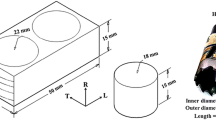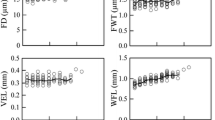Abstract
This experiment describes some anatomical features of Tectona grandis L. relating to the variation of liquid permeability in radial and longitudinal directions. Safranine aqueous solution was used to measure the permeability for its brilliant color and staining properties. Even in presence of abundant rays, penetration depth of liquid in radial direction was found very low in comparison with axial flow. Herein ray length and perimeter of cross-sectional area, interparenchymatous pit number and diameter determined the radial permeability. On the other hand, vessel length and diameter, intervessel pit size, and fiber length affected the longitudinal flow of liquids. Following a go-stop-go cycle, penetration speed of liquid decreased over time.






Similar content being viewed by others
References
Ahmed SA, Chun SK (2007) Descriptions of the wood anatomy and safranine impregnation in Gmelina arborea Roxb. from Bangladesh. J Korea Furnit Soc 18(2):100–105
Ahmed SA, Chun SK (2009) Observation of liquid permeability related to anatomical characteristics in Samanea saman. Turk J Agric For 33(2):155–163
Ahmed SA, Chong SH, Chun SK, Park BS (2006) Ray parenchyma and ray tracheid structure of four Korean pine wood species. J Korea Furnit Soc 17(4):101–107
Ahmed SA, Hong SD, Chun SK (2007) Essential oil penetration depth in Prunus sargentii Rehder. J Korea Furnit Soc 18(4):307–311
Banks WB (1981) Addressing the problem of non-steady state liquid flow in wood. Wood Sci Technol 15(3):171–177
Bao F, Lu J, Avramidis S (1999) On the permeability of main wood species in China. Holzforschung 53(4):350–354
Bao F, Lu J, Zhao J (2000) Effect of bordered pit torus position on permeability in Chinese yezo spruce. Wood Fiber Sci 33(2):193–199
Barnett JR (1982) Plasmodesmata and pit development in secondary xylem elements. Planta 155(3):251–260
Behr EA, Sachs IB, Kukachka BF, Blew JO (1969) Microscopic examination of pressure treated wood. Forest Prod J 19(8):30–40
Bolton AJ, Petty JA (1978) A model describing axial flow of liquid through conifer wood. Wood Sci Technol 12(1):37–48
Carlquist S (2007) Bordered pits in ray cells and axial parenchyma: the histology of conduction, storage, and strength in living wood cells. Botanical J Linnean Soc 153(2):157–168
Choong ET, Tesoro FO (1989) Relationship of capillary pressure and water saturation in wood. Wood Sci Technol 23(2):139–150
Domec JC, Gartner BL (2002) How do water transport and water storage differ in coniferous earlywood and latewood? J Exp Bot 53(379):2369–2379
Dute RR, Rushing AE (1990) Torus structure and development in the wood of Ulmus alata Michx., Celtis laevigata Wild., and Celtis occidentalis L. IAWA J 11(1):71–83
Eaton RA, Hale MD (1993) Wood: decay pests and protection. Chapman & Hall, London
Essiamah S, Eschrich W (1985) Changes of starch content in the storage tissues of deciduous tree during winter and spring. IAWA J 6(2):97–106
Fujii T, Lee SJ, Kuroda N, Suzuki Y (2001) Conductive function of intervessel pits through a growth ring boundary of Machilus thunbergii. IAWA J 22(1):1–14
Furuno T, Imamamura Y, Kajita H (2004) The modification of wood by treatment with low molecular weight phenol-formaldehyde resin: a properties enhancement with neutralized phenolic-resin and resin penetration into wood cell wall. Wood Sci Technol 37(5):349–361
Hacke UG, Sperry JS, Pittermann J (2004) Analysis of circular bordered pit function ii. gymnosperm tracheids with torus-margo pit membranes. Am J Bot 91(3):386–400
IAWA Committee (1989) IAWA list of microscopic features of hardwood identification. IAWA Bull ns 10(3):219–332
Kamke FA, Lee JN (2005) Adhesive penetration in wood-a review. Wood Fiber Sci 39(2):205–220
Keith CT, Chauret G (1988) Anatomical studies of CCA penetration associated with conventional (tooth) and with micro (needle) incising. Wood Fiber Sci 20(2):197–208
Kitin P, Fujii T, Abe H, Takata K (2009) Anatomical features that facilitate radial flow across growth rings and from xylem to cambium in Cryptomeria japonica. Ann Bot 103(7):1145–1157
Leal S, Sousa VB, Pereira H (2007) Radial variation of vessel size and distribution in cork oak wood (Quercus suber L.). Wood Sci Technol 41(4):339–350
Murmanis L, Chudnoff M (1979) Lateral flow in beech and birch as revealed by the electron microscope. Wood Sci Technol 13(2):79–87
Olsson T, Megnis M, Varna J, Lindberg H (2001) Study of the transverse liquid flow paths in pine and spruce using scanning electron microscopy. J Wood Sci 47(4):282–288
Panshin AJ, DeZeeuw C (1974) Textbook of wood technology. McGraw-Hill, New York, p 478
Petty JA (1981) Fluid flow through the vessels and intervascular pits of sycamore wood. Holzforschung 35(5):213–216
Sano Y (2005) Inter- and interspecific structural variation among intervascular pit membranes, as revealed by field-emission scanning electron microscopy. Am J Bot 92(7):1077–1084
Sano Y, Jansen S (2006) Perforated pit membranes in imperforated tracheary elements of some angiosperm. Ann Bot 97(6):1046–1053
Scheikl M, Dunky M (1998) Measurement of dynamic and static contact angles on wood for the determination of its surface tension and penetration of liquids into the wood surface. Holzforschung 52(1):89–94
Schmid R, Machado RD (1968) Pit membranes in hardwoods-fine structure and development. Protoplasma 66(1–2):185–204
Siau JF (1984) Transport process in wood. Springer, Berlin
Siau JF (1995) Wood: influence of moisture on physical properties. Virginia Polytechnic Institute and State University, Blacksburg, 227 pp
Skaar C (1972) Water in wood. Syracuse University Press, New York, 19 pp
Smith WB, Abdullah N, Herdman D, DeGroot RC (1996) Preservative treatment of red maple. Forest Prod J 46(3):35–41
Thomas RJ (1976) Anatomical features affecting liquid permeability in three hardwood species. Wood Fiber 7(4):256–263
Wardrop AB, Davies GW (1961) Morphological factors relating to the penetration of liquids into wood. Holzforschung 15(5):129–141
Acknowledgments
This study was supported by the Korean Institute of Environmental Science and Technology and the Institute of Forest Science, Kangwon National University, Republic of Korea.
Author information
Authors and Affiliations
Corresponding author
Rights and permissions
About this article
Cite this article
Ahmed, S.A., Chun, S.K. Permeability of Tectona grandis L. as affected by wood structure. Wood Sci Technol 45, 487–500 (2011). https://doi.org/10.1007/s00226-010-0335-5
Received:
Published:
Issue Date:
DOI: https://doi.org/10.1007/s00226-010-0335-5




